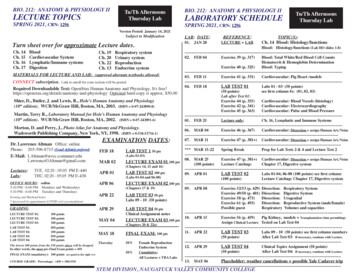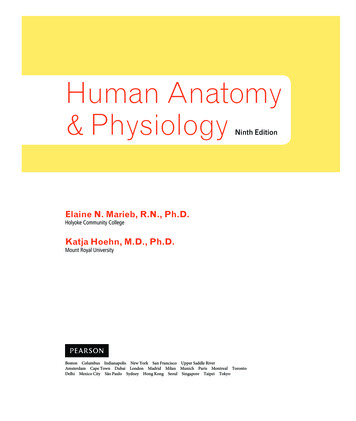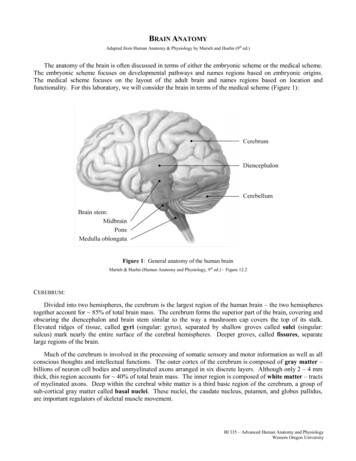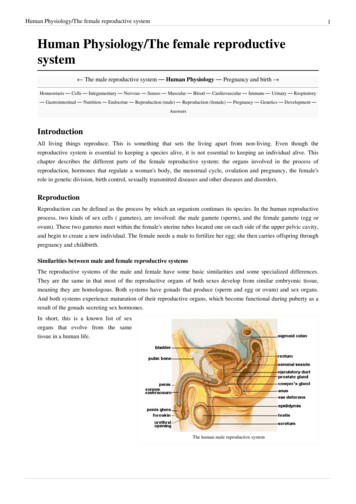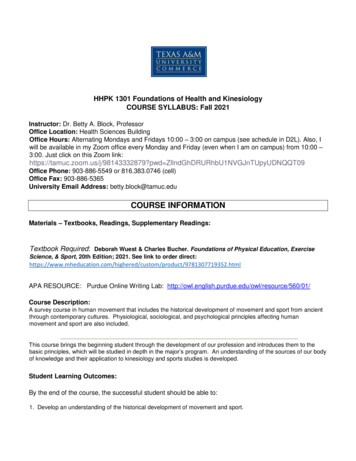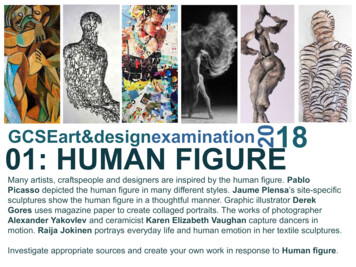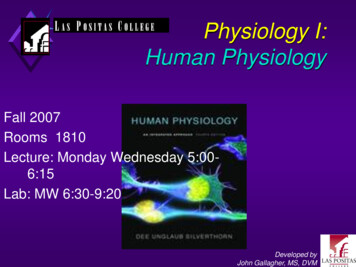
Transcription
Physiology I:Human PhysiologyFall 2007Rooms 1810Lecture: Monday Wednesday 5:006:15Lab: MW 6:30-9:20Developed byJohn Gallagher, MS, DVM
John Gallagher, BS, MS,DVMColorado StateUniversityBS, AnimalSciences, 1974MS, ClinicalSciences, 1976DVM, VeterinaryMedicine, 1980
A Few Details:Turn off your Cell Phone!Review the new Safety Rules in the syllabus.Don’t bother to telephone me.There are new guidelines for microscope use.Email:jgallagher@laspositascollege.eduMy web dex.htmBlackboard: http://clpccd.blackboard.com/
First Assignment!Send me an email beforeSunday, 11:00PM, the first weekof class(3 points!)Always put Physiology in the subjectline.Why are you taking this class?Do you plan a career in the medical field?What special interests do you have?What is your college background?Do you have a job? Where?Who was your Bio 31 instructor?Anatomy?
Textbook, some specialfeatures: Background basicsRUNNINGPROBLEMConcept checksEOC questions andExplorationsSilverthorn web site(http://www.awbc.com/physiologyplace/,or Google physiology
Course IntroductionLectures and exams are textbookbasedLecture Notes: Posted on mywebsite.
About Chapter 1: Introductionto Physiology What is physiology?From cell to human (levels of organization)A review of the organ systemsIntroduction of the concept of homeostasisThemes in PhysiologyThe science of Physiology Experimental designData
Physiology is the study of the function of all plants andanimals in their normal state. an integrative scienceFigure 1-1: Levels of organization and the related fields of study
Review Levels of Organization
Organ Systems operate as integratedunits How many? Can youlist them?Examples: Regulation of Plasma calciumconcentration Blood pressure etc.
Function and Process:Teleological vs. MechanisticApproach to ScienceTeleological:What is purpose or function?Why does something exist?Why does it need to be done?Mechanistic:What are processes involved?How does something work?
Distinguish betweenProcess & FunctionHow do we breathe?Why do we breathe?How does bloodflow?Why does bloodflow?How do RBCstransport O2?Why do RBCtransport O2?Integrate both for complete picture!
Focus on . . . . (Concept)Mapping1.Structure – function maps2.Process maps or FlowchartsFollow process in sequenceFig 1-5b
Key Themes in Physiology:1.Homeostasis (Chapter 6)Body systems work together (Integration offunction)Internal vs. external failure of homeostasis2.Communication and movement acrosscell membranesVital to integration & homeostasisCells communicate with other cells, tissues &organs
Energy Flow and Law of Mass BalanceMajor routesfor input?All living processes requireconstant input of energyWhere from? - How is it stored?How is it used to do work?Major routesfor output?Total amount of substance in body intake production - outputWhat substances are maintained through law of mass balance?
The Science of Physiologyis based on the Scientific MethodReview:1.2.3.4.Basic steps of scientific methodParameters to considerExperimental designAnecdotal evidence
Basic Steps of Scientific Method:Observation (and/or study of priorknowledge)HypothesisExperimentationCollection and analysis of data (can youreplicate results?)Conclusion: reject or accept hypothesistheory
Parameters to consider:Independent vs. dependent variablesControlled byexperimenterResponds to independent variable:gives results.Experimental group vs. control group:only one independent variable is changed
Independent variable ( manipulated, altered variable) ?Dependent variable ( responding to independent variable) ?
Example:Company has found new artificialsweetener (S)Prior knowledge:Some food additives are not safe.Hypothesis: ?Experiments: ?Collect and analyze dataConclusion
Animal vs. Human Experimentation InPhysiology most knowledge is derived fromanimal experimentation. Sometimehuman experimentation necessary. Difficulties Veryof Human Experimentation:dissimilar test subjects Psychological aspects (placebo and nocebo effects) Ethical questions (is it o.k. to withhold potentialdrug from seriously ill?)
Experimental Design forHuman StudiesBlind study (subjects do not know if they gettreatment or placebo)Double blind study (subjects & administrators . . .)Cross over study (each subject participates inexperimental AND control group)Double blind cross over study
Experimental Design forHuman Studies cont.Longitudinal studiesProspective studiesCross-sectional studiesRetrospective studiesMeta-analysis
Development ofpharmaceutical drugs (not in book)In vitrofewIn vivo tests on lab animals 10%In vivo human clinical trials (3 phases)FDA approval
Focus on Graphs Data are often presented in form of agraph For examples see Fig 1-8
Experimental Design for Human Studies cont. Longitudinal studies Prospective studies Cross-sectional studies Retrospective studies Meta-analysis . Development of pharmaceutical drugs (not in book) In vitro In vivo tests on lab animals


